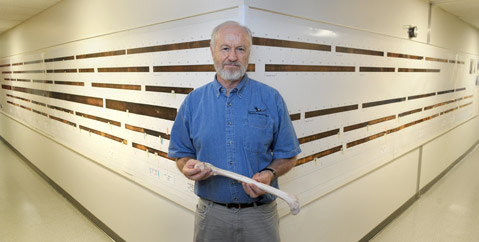Hunting the Early Humans
Museum of Natural History Hosts Second Symposium on Human Origins

Once we figured out food, sex, and shelter, it’s likely that our oldest ancestor’s next thought was, “Where did we come from?” The search continues today, and with the emergence of increasingly precise genetic technology, the experts are shining a much brighter light on certain answers than ever before. The latest discoveries will be discussed and debated in Santa Barbara this weekend by top researchers from around the globe as part of the Symposium of Human Origins II, put on by the S.B. Museum of Natural History.
One such expert is Texas A&M’s Mike Waters, director of the Center for the Study of the First Americans. At the forefront of proving that the Americas were settled thousands of years earlier than once thought, Waters actually comes from a geology background, which is handy in determining how old the stone tools are at the ancient sites he studies from Texas to Florida. He’s shown conclusive evidence that shows human presence on the continent back some 15,000 years. That’s 2,000 years before the Clovis people, which was the leading paradigm for decades that he says is now “thrown at the window.” Currently, most agree that humans came here at least 16,000 years ago. “That’s what the modern genetic data is showing, as well,” he explained. How we got here, though, isn’t quite so decided. “Archaeology, especially for first Americans, is kind of like a horse race,” explained Waters, who tends toward the Bering Strait theory but is aware of ideas ranging from Polynesia to the Iberian Peninsula. “There are a lot of different opinions.”
Also attending is Bernard Comrie, who studies how human language evolved and spread around the world. Genetics is also supporting much of his work, such as how the native languages of Madagascar off the African coast are actually related to the Southeast Asian island of Borneo. Able to give lectures in about six languages, converse in about 20, and utter phrases in more than 100, Comrie — who splits his time between a home near Palos Verdes and an office at the Leipzig University in Germany — is ringing the alarm about the loss of languages worldwide, such as in Papua New Guinea, where the English derivative Tok Pisin (as in, “talk pidgin”) is overcoming the nearly 1,000 native tongues. “The process that led to language shift in the past are much more prevalent today … and the world is starting to become homogenized,” said Comrie. “Each language presents us with a slightly or significantly different way of analyzing the world. We are losing that.”
Altogether, the discussions this weekend speak to an even wider understanding of our existence. “Really, it’s the story of ourselves, how modern humans explored and eventually settled all the land masses of earth,” said Waters. “That’s important for us to know.”
4·1·1
The S.B. Museum of Natural History’s Symposium on Human Origins II takes place at the museum Friday, September 12, and the Lobero Theatre on Saturday, September 13, ending with an evening banquet at the museum. See sbnature.org or call 682-4711 for tickets.



